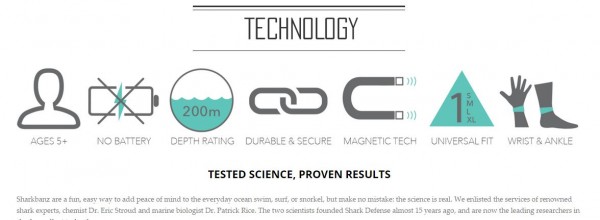A New Bracelet Scam That Will Take a Bite Out of Your Wallet
Sometimes I wish that I didn’t have a nagging conscience so that I could make millions selling crap at a 6000% profit just by claiming that it does something it doesn’t. Unfortunately, I’d be embarrassed by the first skeptic to challenge me. Oh, and then there’s that pesky fact that I’d be scamming people and promoting pseudoscience.
Anyway, there seems to be no end to the things you can convince people that some token item embedded in $.08 worth of rubber can do.
Last week I stumbled over Sharkbanz™.
Sharkbanz™ are rubber jewelry similar to a Fitbit Flex™. Instead of a motion sensor, however, Sharkbanz™ contain magnets. The company’s founders claim that these magnets repel sharks.
Yes, you read that right. Magnets in a rubber bracelet repel sharks.
How does it work? Well, let’s look at what they claim.
Summary:
- Uses magnets
- No batteries, no electricity, no moving parts
- Rated for 200 meters. What happens when you dive below that? Does the magnet implode or the rubber erode?
- For ages 5 and up. So if you’re 4, you’re some Shark’s dinner I guess, because for some reason it is just not safe for those under 5. By the way, choking hazard warnings are usually for children under 3, so this arbitrary value makes little sense.
The idea is that sharks are annoyed or frightened by the electromagnetic field emitted by the magnet because of their keen electroreception capabilities.
Okay, so I’m not a shark expert, nor am I a physicist or an engineer. For this reason, I’m going to tread a little lightly on the examination of whether the idea is plausible and focus on whether they have demonstrated that the things work. But I will admit to a bit of skepticism given the knowledge I do have. Some of my thoughts:
- I don’t know that the differences between magnetic fields, electrical impulses, and electromagnetic fields matter, but the owners of Sharkbanz imply that any electromagnetic energy is disturbing to sharks. If that were true, then light would bother them. Clearly, just as the human eye only senses electromagnetic energy within a range of wavelengths, sharks’ electroreceptors are limited in range. Yet the website says very little about what research and testing they have done to determine whether sharks even sense their magnets. The most that I can find is a link to a list of tested species on the website of a group called SharkDefense. There is zero detail provided in this list and no citations to peer-reviewed literature about these tests. The site does cite some literature in a section which explains the theory (which, again, I am unqualified to adequately challenge, but it looks mostly correct), but provides no reason to believe that the idea because sharks have electroreception, they will be repelled by this specific small magnet wrapped in a rubber bracelet. In fact, take a look at the size of the magnet the claim to have tested (again, no citation for this): Click here
- Sharkbanz™ presents no reason that a man-eating shark would have for avoiding the electromagnetic field emitted by their magnets. Just because sharks have electroreceptors doesn’t mean that some random magnet is going to affect their behavior. Perhaps if they made an effort to produce some magnet that emitted a field that mimicked the energy put out by a predator it might make sense, but do bull sharks even have predators? I don’t know, but I’m skeptical.
- Then there’s the fact that the magnet is encased in rubber.
So if you’re an expert on sharks or the physics that apply here, please feel free to comment with your 2 cents, but I’m going to focus on their “scientific testing”.
Sharkbanz are a fun, easy way to add peace of mind to the everyday ocean swim, surf, or snorkel, but make no mistake: the science is real.
Bull*cough*.
This technology has been tested extensively on over ten of the most common predatory shark species…
On the website, there are several references to videos that supposedly show this “extensive testing”. However, most of the videos I’ve found when I click those links are media interviews in which the owners say very little. There are certainly no published articles from peer-reviewed journals, not even some about electroreceptors in sharks that don’t really support their claims. They don’t even try to fake it. What I did find are a few unconvincing videos which show a couple of guys dropping a buoy into the water and watching a fish or two swim away from it.
In this video, the only one that claims to show testing, the voiceover claims that they tied a bracelet to a buoy “in order to be scientific” as well as safe before throwing it into the water with reef sharks. Then, he put two shark bands on his ankles and got into the water which, he claims, induced “obvious repellent reactions when the sharks approached the bands on my feet”. Finally, they “decided to get more of the controlled type of testing” by tying the bracelets around lead weights, which he claims produced “really astonishing repellent behavior”.
Well, I’m sorry guys, but scientists everywhere are laughing at you. They are giving you the virtual equivalent of “there, there” pats on the head and “aren’t you cute? Do you want to be a scientist when you grow up?” Except that given the voice on this video belongs to Dr. Patrick Rice, Senior Marine Biologist at SharkDefense, you’ll have a hard time convincing me that you don’t know quite well that you’re not scientifically testing anything. This is a marketing video and nothing more.
A very short, far-from-exhaustive list of plausible alternative explanations for what the video shows:
- fish in the shots are not darting away from the bracelet, but rather toward food that was just dropped in the water
- cherry-picking shots in which fish are swimming away
- fish examined the item (or the person) and immediately recognized that it wasn’t food (or preferred food)
- fish avoid things hanging from buoys or anything that looks like the item (rather than being repelled by the magnet)
Can you guess what a good, scientific test of this product might entail? A double-blind, placebo controlled study. In other words, you’d want to simulate the movement of a human being as much as possible. You’d want to stop chumming the water after you’ve introduced the treatment (the bracelet). Most of all, you would need to compare the fishes’ behavior toward a Sharkbanz™ bracelet to their behavior toward a placebo–a bracelet without the magnet. Also, you would need the people recording and judging the behavior to be blind to the condition (they cannot know whether the fish are reacting to an “active” bracelet or a placebo). Without that comparison all of these tests are worthless.
In sum, these guys are charging $60 for heavy rubber bracelet that people will buy because it claims to protect from shark attacks–an extremely rare event with a high fear factor.
In the U.S., it takes a lot of time and money to get a group like this to stop making ridiculous claims, but I have to wonder how this company is allowed to market and sell in Australia, given what happened with Power Balance.





